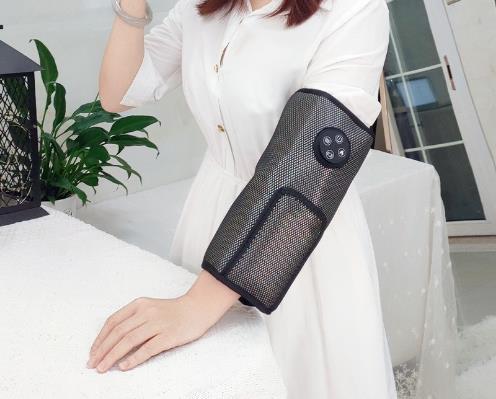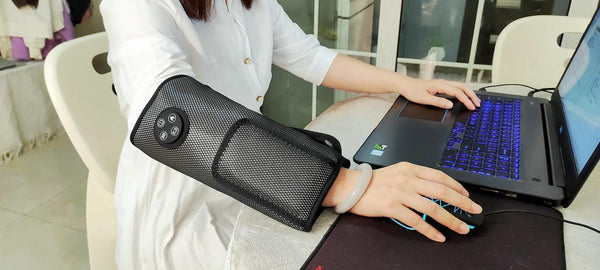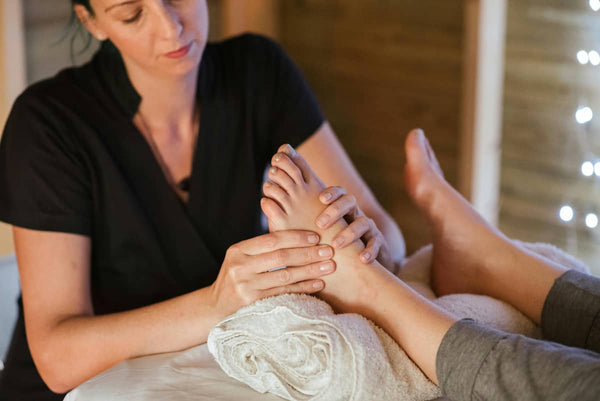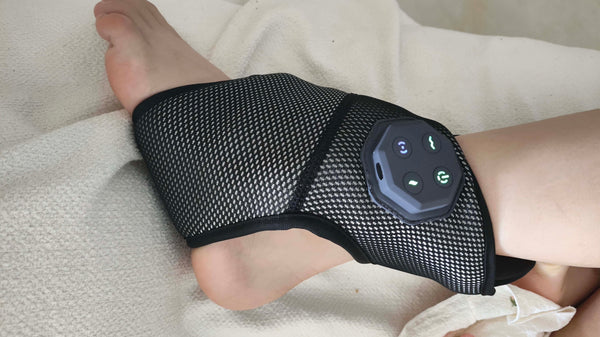
You’ve seen them, perhaps even used one: those sleek hand massager machines that promise to melt away tension and soothe tired hands. But a question often lingers in the back of your mind, especially after a deep session like our kitchen worker friend experienced, leaving temporary indentation marks: Are these devices truly safe? Or could that intense pressure actually be doing more harm than good, maybe even causing a bruise or two? As a rehabilitation physiotherapist, I get these questions all the time, particularly from middle-aged and elderly fitness enthusiasts who rely on their hands for everything from gardening to lifting weights.
The core of this discussion revolves around understanding the balance between effective deep pressure and potential risks. Many believe that the temporary indentations are simply a normal sign of effective deep tissue work—a good kind of pressure. Yet, others worry about overly aggressive massagers leading to adverse reactions. My goal is to navigate this controversial focus, providing clarity on the safety and effectiveness of these handy gadgets, ensuring you can make informed choices for your hand health.
Are Hand Massager Machines Safe?
Generally speaking, yes, hand massager machines are considered safe for most users when used correctly and according to manufacturer guidelines. The temporary indentation marks that some users observe are indeed often the result of the normal operation of deep pressure equipment. Think of it like sitting on a patterned cushion – the pattern might briefly imprint on your skin. These marks are usually benign and disappear within minutes, indicating that the device has applied effective compression to stimulate blood flow and release muscle tension.
However, the line between beneficial pressure and problematic force can be fine. While many individuals find profound relief from the deep, kneading action, some users are rightly concerned that overly aggressive massagers may lead to bruising or other adverse reactions. This is particularly true if the intensity is set too high for a prolonged period, or if the user has pre-existing conditions like fragile skin, circulation issues, or certain inflammatory conditions. It's about finding that sweet spot where the pressure brings comfort, not discomfort. Like any good workout, it should feel like a satisfying challenge, not a painful ordeal.
For individuals with conditions that might benefit from targeted relief, like those considering a carpal tunnel wrist splint or a hand brace for carpal tunnel, a gentle hand massager machine could be a complementary tool, but only under guidance. The key is moderation and listening to your body. As a physiotherapist, I always advise starting with the lowest setting and gradually increasing intensity only if comfortable. No pain, no gain does *not* apply here; pain means stop.
Why Do Hand Massages Hurt?
If a hand massage, particularly from a machine, leaves you wincing, it's a clear signal something isn't quite right. While some discomfort can be expected as tight muscles release, sharp or persistent pain is your body's way of saying, "Hold on a minute!" This can stem from several factors, often related to the intensity of the massage, underlying conditions, or even incorrect usage.
Firstly, the massage intensity might simply be too high for your current level of muscle tension or sensitivity. If your hands are severely knotted or inflamed, even moderate pressure can feel intense. Secondly, underlying issues like trigger points – those notoriously painful knots in your muscles – can be highly sensitive to direct pressure. Hitting one with a massager can elicit a strong, even radiating, pain. And let's not forget neurological sensitivities; conditions like carpal tunnel syndrome can make the median nerve incredibly tender, so any significant pressure around the wrist area can cause a jolt. This is precisely why someone might be looking for a wrist brace for carpal tunnel in the first place.
My advice? Always choose a milder brand or model for your hand massager machine, especially if you're new to them or have sensitive hands. The Klcosy brand, for instance, has a reputation for offering a more controlled and gentle yet effective experience, prioritizing safety and comfort. Alternatively, adopting manual techniques or seeking a professional physiotherapist for a personalized massage can provide the necessary relief without the risk of over-aggression. Sometimes, the human touch, with its innate ability to adapt pressure in real-time, is truly unbeatable.
Navigating the Nuances: Choosing the Right Hand Massager Machine and Techniques
The market is flooded with hand massager machines, each promising unique benefits. How do you choose one that's not only effective but also aligns with your safety and comfort needs? It comes down to understanding your needs and prioritizing intelligent design over raw power. You might be surprised to find out that bigger isn't always better when it comes to soothing your hardworking hands.
I always recommend prioritizing ergonomically designed massagers with powerful *and* multi-functional features, rather than relying solely on large, industrial-strength medical equipment. Why? Because the best device is one you'll actually use consistently and safely. Look for models that offer adjustable intensity settings, heat therapy, and different compression patterns. This allows you to tailor the experience to your specific needs, whether you're targeting a deep knot or just seeking gentle relaxation after a long day of fitness activities. A machine that allows for nuanced control is far superior to one that only offers a single, aggressive setting. A softer touch often yields better results, especially for middle-aged and elderly users.
Furthermore, don't underestimate the power of manual techniques. Simple self-massage using your thumb and fingers can be incredibly effective for localized tension. You can gently knead the palm, trace along the bones of your fingers, and apply pressure to the web spaces between your fingers. Combining these manual approaches with a high-quality, user-friendly hand massager machine like the Klcosy can create a comprehensive hand care routine. The key is to be attentive and responsive to what your hands are telling you. If a particular movement or pressure causes pain, back off immediately. It’s not a race; it’s a journey toward lasting comfort.
Proactive Protection: Supporting Your Hands Beyond Massage
 While a good hand massager machine is a fantastic tool, true hand care goes beyond massage. It's about creating a holistic strategy that supports your hands and wrists throughout your daily life. Think of it as building a fortified castle around your most valuable assets, preparing them for the rigors of whatever you throw their way, from kitchen work to intense gym sessions.
While a good hand massager machine is a fantastic tool, true hand care goes beyond massage. It's about creating a holistic strategy that supports your hands and wrists throughout your daily life. Think of it as building a fortified castle around your most valuable assets, preparing them for the rigors of whatever you throw their way, from kitchen work to intense gym sessions.
For individuals facing specific challenges like Carpal Tunnel Syndrome, integrating supportive devices can be crucial. A well-fitted carpal tunnel wrist splint or a general hand brace for carpal tunnel can provide much-needed stability and reduce nerve compression, especially during sleep or repetitive tasks. These are not cures, but vital aids in managing symptoms and preventing exacerbation. Similarly, a specialized wrist brace for carpal tunnel can offer targeted support, allowing the wrist to remain in a neutral, healing position. These braces complement the benefits of massage by providing structural support.
Moreover, enhancing physical resilience through cross-training, such as yoga and strength training, is paramount. Yoga improves flexibility and strengthens the small muscles in the hands and forearms, while light strength training (using resistance bands or light weights) can build overall arm and grip strength, creating a stronger foundation. These proactive measures, combined with the occasional soothing session from your hand massager machine, create a comprehensive regimen that protects your hands and ensures they remain strong, flexible, and pain-free, no matter your profession or passion.
Can You Get STD from Hand Massage?
This is a question that occasionally pops up, and it's essential to address it directly and clearly, as confusion can cause unnecessary concern. The straightforward answer is: No, you cannot contract a sexually transmitted disease (STD) from a typical hand massage. STDs are transmitted through specific types of unprotected sexual contact, involving the exchange of bodily fluids like semen, vaginal fluids, blood, or direct skin-to-skin contact with infected areas. A standard hand massage, where only hands are involved in manipulation and no exchange of these fluids occurs, does not pose a risk for STD transmission. It’s simply not the mechanism by which these infections spread.
When getting any type of massage, whether from a professional or using a hand massager machine, the primary concern from a health perspective should always be hygiene. Ensure that any equipment is clean, and if receiving a manual massage, that the therapist practices good hand hygiene. The idea of getting an STD from a hand massage typically stems from misinformation or a misunderstanding of how these infections are transmitted. Rest assured, your hand massager is focused solely on muscle relaxation and blood circulation, not on anything that could transmit an STD. Focus on the fantastic relief it can bring to your overworked hands!
Your hands are invaluable, carrying you through daily tasks and professional endeavors. By understanding the nuances of hand massager machines, combining them with smart choices and proactive care, you empower yourself to keep your hands healthy and strong for years to come. Don't let uncertainty keep you from the relief you deserve!
Ready to experience safe, effective hand relief?
Subscribe for More Hand Health Insights
This reply is generated based on currently verifiable public information. It is recommended to cross-check key content with authoritative sources.




0 comments